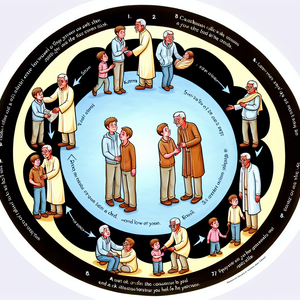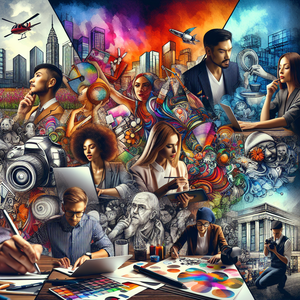The Spectrum of Creative Careers: Harnessing the Power of Color

Color is more than just a visual element; it evokes emotions, influences decisions, and can even alter perceptions. For creative professionals, an understanding of color theory is essential. It involves knowing how colors interact, how they can be combined to create harmony or contrast, and how they can be used to convey specific messages. Whether it’s a graphic designer creating eye-catching marketing materials or a fashion stylist curating a vibrant wardrobe, the strategic use of color can elevate their work and resonate with audiences on a deeper level.
Careers that Embrace Color
1. Graphic Design: Graphic designers are often tasked with creating visually engaging content that captures attention. They use color strategically to evoke emotions or highlight key messages. For instance, a designer might choose warm colors like red and orange to create a sense of urgency in a call-to-action or opt for cool colors like blue and green to convey calmness in a wellness brand. The color choices can significantly impact how a brand is perceived, making graphic design a crucial field in the realm of visual communication. 2. Fashion Design: In the fashion industry, color is pivotal in setting trends and communicating style. Designers often draw inspiration from seasonal palettes and cultural influences. A successful fashion designer not only understands color theory but also anticipates how colors will evolve over time. For example, Pantone's Color of the Year often influences collections across the industry, showcasing how color can shape fashion narratives. The ability to predict and harness color trends can make or break a designer's career. 3. Interior Design: Interior designers harness the power of color to create spaces that reflect personality and mood. They carefully consider the psychological effects of color when designing a room. For instance, soft blues and greens can create a serene atmosphere, making them ideal for bedrooms, while bright yellows and oranges can energize a workspace. By understanding how color affects human behavior, interior designers can create environments that enhance the quality of life for their clients. 4. Photography: Photographers use color to tell stories and evoke feelings. The choice of color in photography can drastically change the mood of an image. For example, a photograph with saturated colors may evoke a sense of joy and vibrancy, while muted tones may convey nostalgia or melancholy. Photographers often manipulate color during editing to enhance the emotional impact of their work. The use of color filters, gels, and post-processing techniques allows photographers to create a unique visual narrative that resonates with viewers. 5. Fine Arts: Artists have long used color as a medium of expression. From Impressionists who captured light through color to contemporary artists who explore the psychological implications of hues, color remains a fundamental element of artistic creation. Understanding how to mix colors and create visual harmony is crucial for artists aiming to evoke emotion and provoke thought in their audience. Famous artists like Vincent van Gogh and Claude Monet demonstrated how color could communicate mood and atmosphere, influencing countless artists who followed.
Tips for Aspiring Creatives
For those looking to enter a creative field that celebrates the spectrum of colors, here are some tips to get started: - Study Color Theory: Invest time in learning the basics of color theory. Understanding the color wheel, complementary colors, and the emotional impact of different hues will provide a strong foundation for creative work. - Experiment and Practice: Don’t be afraid to experiment with color in your projects. Create mood boards, play with different palettes, and practice mixing colors until you find combinations that resonate with you. The process of trial and error can lead to unexpected and delightful results. - Seek Inspiration: Look for inspiration in nature, art, fashion, and design. The world around you is filled with color palettes waiting to be discovered and translated into your work. Visiting art galleries, exploring fashion trends, or even taking walks in nature can spark creativity. - Build a Portfolio: As you create, compile your work into a portfolio that showcases your understanding of color and design. A strong portfolio can be a powerful tool when seeking opportunities in the creative industry, demonstrating your unique style and skills. - Network with Professionals: Connect with other creatives in your field. Attend workshops, join online forums, or participate in local art shows. Networking can provide valuable insights and open doors to future opportunities, fostering collaboration and mentorship.
The spectrum of creative careers is as vibrant and diverse as the colors it encompasses. From graphic designers to fashion stylists, professionals harness the power of color to inspire, evoke emotions, and convey messages. As aspiring creatives explore their passions, understanding the role of color in their work can set them apart in a competitive landscape. By embracing color theory and experimenting with various palettes, they can unlock their potential and create visually stunning pieces that resonate with audiences everywhere. In a world where color is a universal language, the opportunities for creativity are limitless. Whether you’re looking to become a professional in one of these fields or simply want to explore your creative side, remember that the beauty of color is waiting to be harnessed and celebrated.
Color Consultant
Design agencies, marketing firms, retail brands
Core Responsibilities
Analyze color trends and their psychological impacts on consumer behavior.
Provide recommendations for color schemes in branding, product design, and marketing campaigns.
Collaborate with designers and clients to develop cohesive color palettes.
Required Skills
Strong understanding of color theory and its application in various industries.
Excellent communication skills for presenting ideas and concepts to clients.
Proficiency in design software such as Adobe Creative Suite.
UX/UI Designer
Tech companies, startups, digital marketing agencies
Core Responsibilities
Create user-friendly interfaces that effectively incorporate color to enhance usability and aesthetics.
Conduct user research and testing to understand how color impacts user experience.
Develop wireframes and prototypes that clearly communicate design ideas.
Required Skills
Expertise in design tools like Sketch, Figma, or Adobe XD.
Knowledge of accessibility standards related to color usage.
Strong analytical skills to interpret user feedback and analytics data.
Fashion Stylist
Fashion magazines, styling agencies, personal branding firms
Core Responsibilities
Curate outfits and looks that highlight color trends for various occasions or photoshoots.
Collaborate with photographers, models, and designers to create visually compelling presentations.
Stay updated on fashion trends and seasonal palettes to advise clients effectively.
Required Skills
Strong sense of style and an eye for color coordination.
Excellent networking skills to build relationships with brands and designers.
Experience in fashion merchandising or retail can be beneficial.
Interior Color Specialist
Interior design firms, home improvement stores, real estate staging companies
Core Responsibilities
Advise clients on color choices that create desired moods and aesthetics in residential or commercial spaces.
Develop color palettes that align with clients’ personal styles or brand identities.
Collaborate with architects and interior designers to ensure cohesive design elements.
Required Skills
Deep knowledge of color psychology and its effects in interior spaces.
Strong visualization skills to help clients imagine final outcomes.
Familiarity with design software and tools for color visualization.
Digital Illustrator
Publishing companies, game studios, advertising agencies
Core Responsibilities
Create illustrations that effectively utilize color to convey narratives or thematic elements.
Collaborate with authors, game developers, or brands to produce visually engaging content.
Adapt color schemes based on client feedback and project requirements.
Required Skills
Proficiency in illustration software such as Adobe Illustrator and Procreate.
Strong artistic skills with a keen understanding of color blending and shading techniques.
Ability to work under tight deadlines while maintaining quality.


